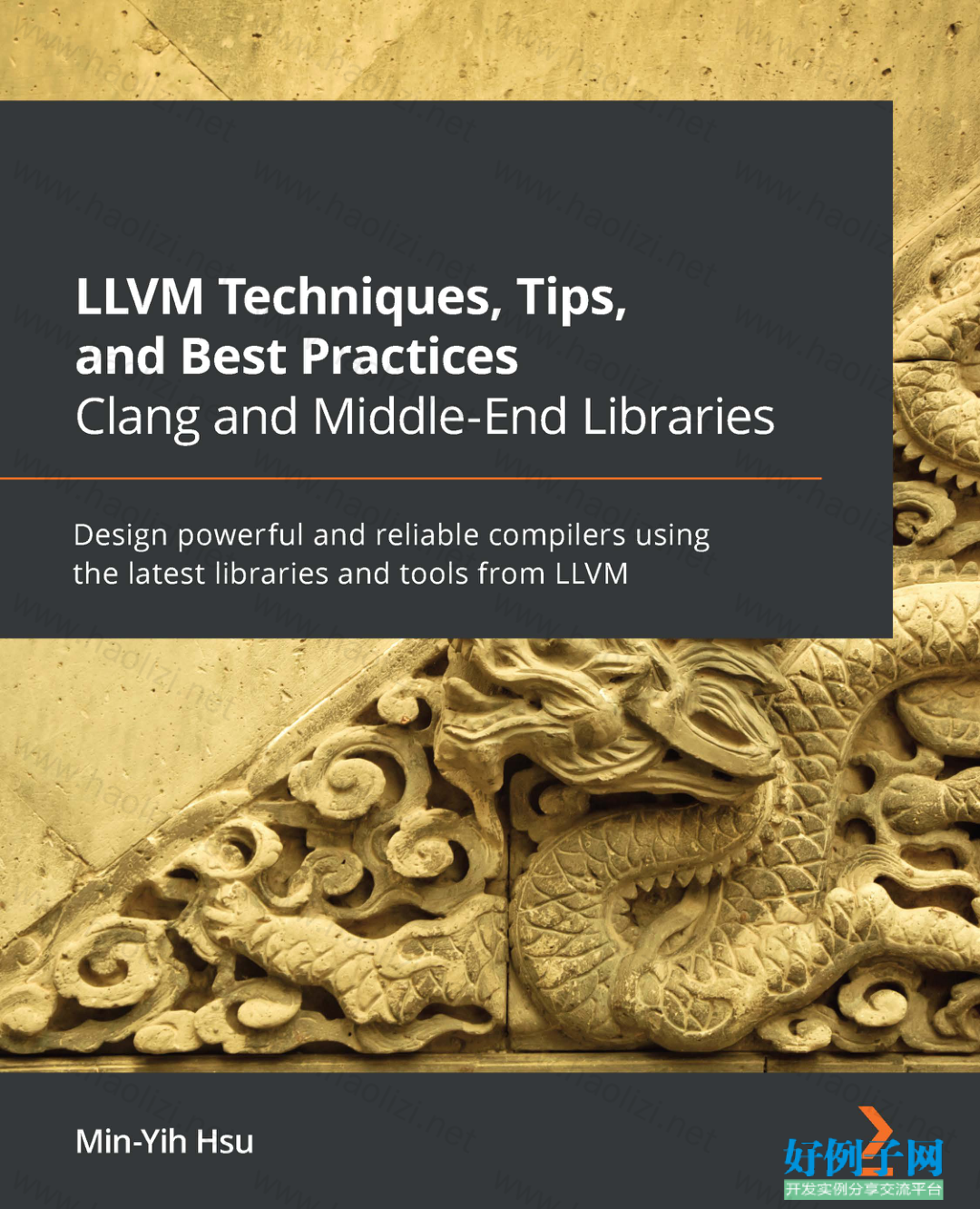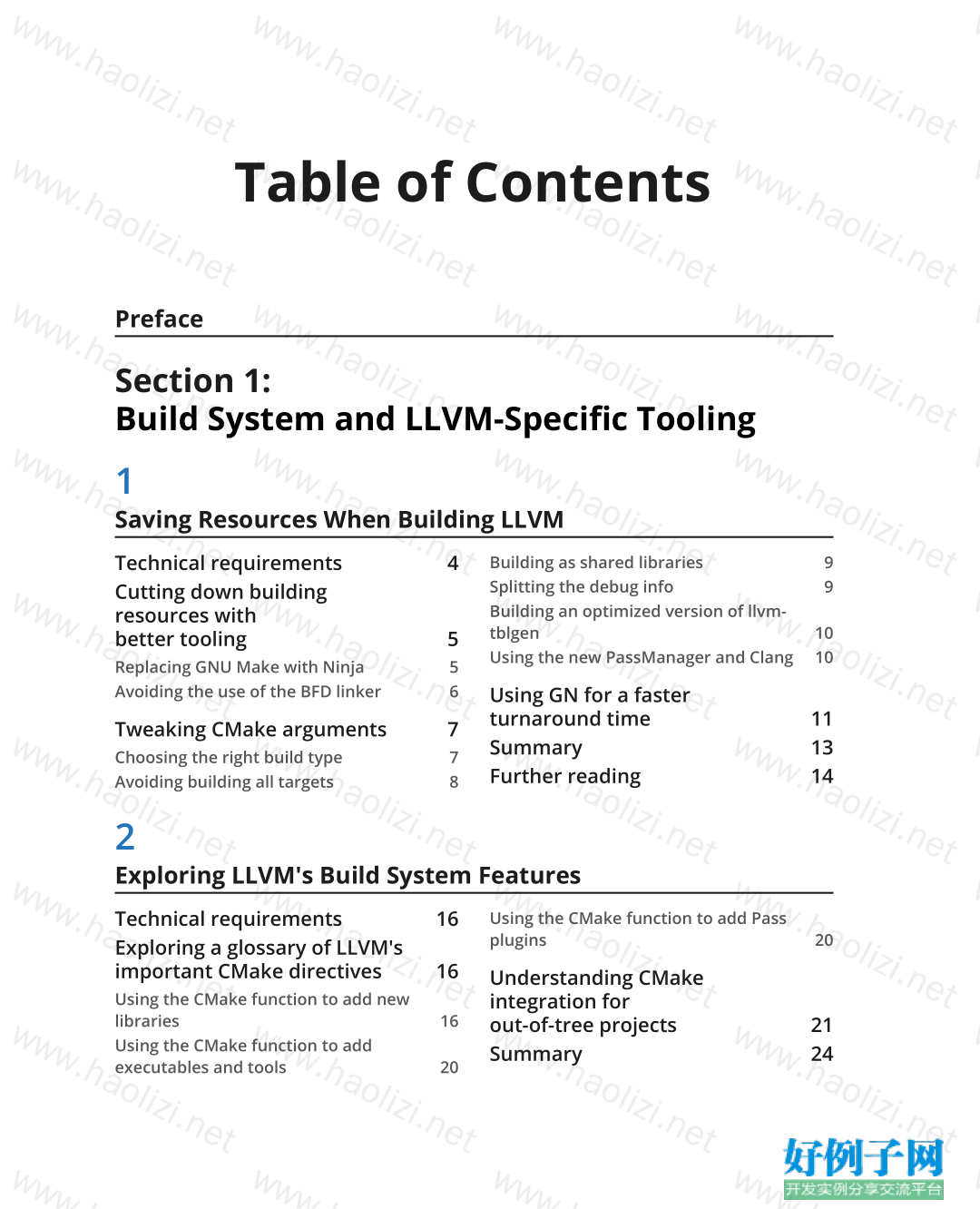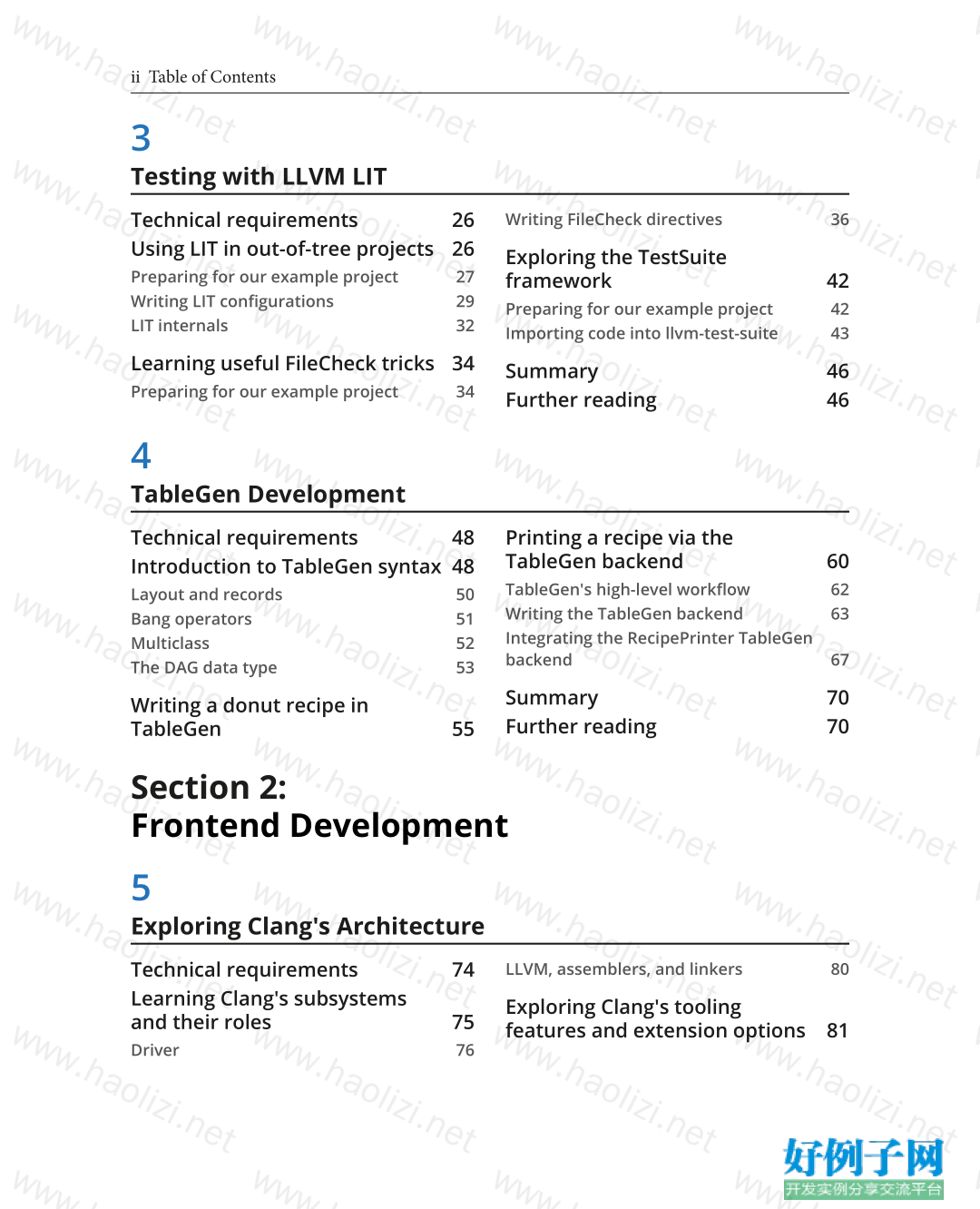实例介绍
【实例截图】






【核心代码】
Table of Contents
Preface
Section 1:
Build System and LLVM-Specific Tooling
1
Saving Resources When Building LLVM
Technical requirements 4
Cutting down building
resources with
better tooling 5
Replacing GNU Make with Ninja 5
Avoiding the use of the BFD linker 6
Tweaking CMake arguments 7
Choosing the right build type 7
Avoiding building all targets 8
Building as shared libraries 9
Splitting the debug info 9
Building an optimized version of llvm-
tblgen 10
Using the new PassManager and Clang 10
Using GN for a faster
turnaround time 11
Summary 13
Further reading 14
2
Exploring LLVM's Build System Features
Technical requirements 16
Exploring a glossary of LLVM's
important CMake directives 16
Using the CMake function to add new
libraries 16
Using the CMake function to add
executables and tools 20
Using the CMake function to add Pass
plugins 20
Understanding CMake
integration for
out-of-tree projects 21
Summary 24
ii Table of Contents
3
Testing with LLVM LIT
Technical requirements 26
Using LIT in out-of-tree projects 26
Preparing for our example project 27
Writing LIT configurations 29
LIT internals 32
Learning useful FileCheck tricks 34
Preparing for our example project 34
Writing FileCheck directives 36
Exploring the TestSuite
framework 42
Preparing for our example project 42
Importing code into llvm-test-suite 43
Summary 46
Further reading 46
4
TableGen Development
Technical requirements 48
Introduction to TableGen syntax 48
Layout and records 50
Bang operators 51
Multiclass 52
The DAG data type 53
Writing a donut recipe in
TableGen 55
Printing a recipe via the
TableGen backend 60
TableGen's high-level workflow 62
Writing the TableGen backend 63
Integrating the RecipePrinter TableGen
backend 67
Summary 70
Further reading 70
Section 2:
Frontend Development
5
Exploring Clang's Architecture
Technical requirements 74
Learning Clang's subsystems
and their roles 75
Driver 76
LLVM, assemblers, and linkers 80
Exploring Clang's tooling
features and extension options 81
Table of Contents iii
The FrontendAction class 81
Clang plugins 82
LibTooling and Clang Tools 83
Summary 85
Further reading 85
6
Extending the Preprocessor
Technical requirements 88
Working with SourceLocation
and SourceManager 89
Introducing SourceLocation 89
Introducing SourceManager 90
Learning preprocessor and
lexer essentials 91
Understanding the role of the
preprocessor and lexer in Clang 92
Understanding Token 93
Handling macros 97
Developing custom
preprocessor plugins and
callbacks 99
The project goal and preparation 100
Implementing a custom pragma
handler 103
Implementing custom preprocessor
callbacks 105
Summary 108
Exercises 109
7
Handling AST
Technical requirements 112
Learning about AST in Clang 113
In-memory structure of Clang AST 113
Types in Clang AST 116
ASTMatcher 118
Writing AST plugins 125
Project overview 125
Printing diagnostic messages 128
Creating the AST plugin 132
Summary 144
8
Working with Compiler Flags and Toolchains
Technical requirements 146
Understanding drivers and
toolchains in Clang 147
Adding custom driver flags 150
Project overview 150
Declaring custom driver flags 152
Translating custom driver flags 155
Passing flags to the frontend 161
iv Table of Contents
Adding a custom toolchain 163
Project overview 164
Creating the toolchain and adding a
custom
include path 167
Creating a custom assembling stage 170
Creating a custom linking stage 173
Verifying the custom toolchain 177
Summary 178
Exercises 179
Section 3:
"Middle-End" Development
9
Working with PassManager and AnalysisManager
Technical requirements 184
Writing an LLVM Pass for the
new PassManager 185
Project overview 186
Writing the StrictOpt Pass 189
Working with the new
AnalysisManager 196
Overview of the project 196
Writing the HaltAnalyzer Pass 198
Learning instrumentations in
the new PassManager 202
Printing Pass pipeline details 203
Printing changes to the IR after each
Pass 205
Bisecting the Pass pipeline 207
Summary 208
Questions 209
10
Processing LLVM IR
Technical requirements 212
Learning LLVM IR basics 213
Iterating different IR units 216
Iterating instructions 216
Iterating basic blocks 219
Iterating the call graph 224
Learning about GraphTraits 225
Working with values and
instructions 229
Understanding SSA 229
Working with values 232
Working with instructions 235
Working with loops 242
Learning about loop representation in
LLVM 243
Learning about loop infrastructure in
LLVM 247
Summary 254
Table of Contents v
11
Gearing Up with Support Utilities
Technical requirements 256
Printing diagnostic messages 257
Collecting statistics 260
Using the Statistic class 261
Using an optimization remark 264
Adding time measurements 272
Using the Timer class 273
Collecting the time trace 276
Error-handling utilities in LLVM 279
Introducing the Error class 280
Learning about the Expected
and ErrorOr classes 285
The Expected class 285
The ErrorOr class 287
Summary 289
12
Learning LLVM IR Instrumentation
Technical requirements 292
Developing a sanitizer 293
An example of using an address
sanitizer 293
Creating a loop counter sanitizer 296
Working with PGO 316
Introduction to instrumentation-based
PGO 317
Introduction to sampling-based PGO 318
Using profiling data analyses 329
Summary 334
Assessments
Other Books You May Enjoy
Index
标签: LLVM\
LLVM教程-Min-Yih Hsu - LLVM Techniques, Tips, and Best Practices_ Clang and Middle-End Libraries-Packt Publishing (2021)
小贴士
感谢您为本站写下的评论,您的评论对其它用户来说具有重要的参考价值,所以请认真填写。
- 类似“顶”、“沙发”之类没有营养的文字,对勤劳贡献的楼主来说是令人沮丧的反馈信息。
- 相信您也不想看到一排文字/表情墙,所以请不要反馈意义不大的重复字符,也请尽量不要纯表情的回复。
- 提问之前请再仔细看一遍楼主的说明,或许是您遗漏了。
- 请勿到处挖坑绊人、招贴广告。既占空间让人厌烦,又没人会搭理,于人于己都无利。
关于好例子网
本站旨在为广大IT学习爱好者提供一个非营利性互相学习交流分享平台。本站所有资源都可以被免费获取学习研究。本站资源来自网友分享,对搜索内容的合法性不具有预见性、识别性、控制性,仅供学习研究,请务必在下载后24小时内给予删除,不得用于其他任何用途,否则后果自负。基于互联网的特殊性,平台无法对用户传输的作品、信息、内容的权属或合法性、安全性、合规性、真实性、科学性、完整权、有效性等进行实质审查;无论平台是否已进行审查,用户均应自行承担因其传输的作品、信息、内容而可能或已经产生的侵权或权属纠纷等法律责任。本站所有资源不代表本站的观点或立场,基于网友分享,根据中国法律《信息网络传播权保护条例》第二十二与二十三条之规定,若资源存在侵权或相关问题请联系本站客服人员,点此联系我们。关于更多版权及免责申明参见 版权及免责申明



网友评论
我要评论